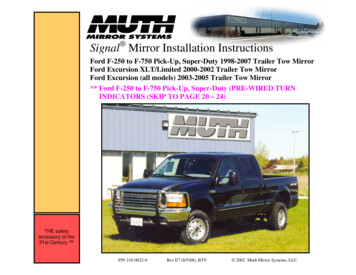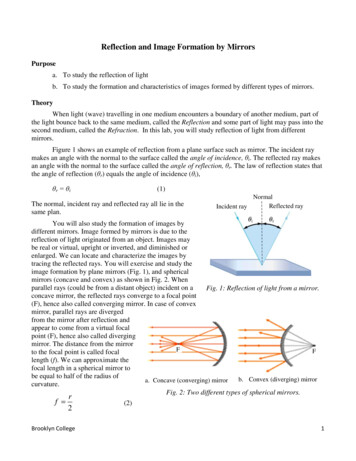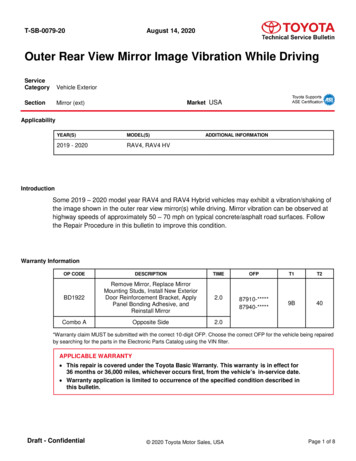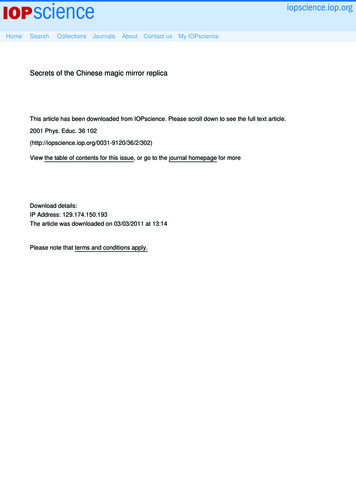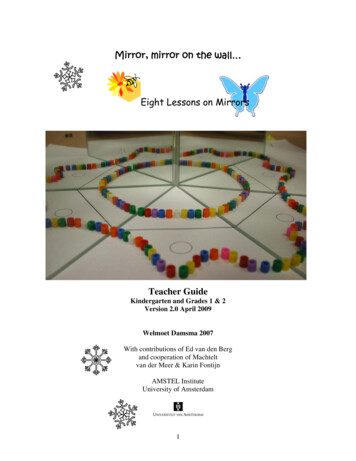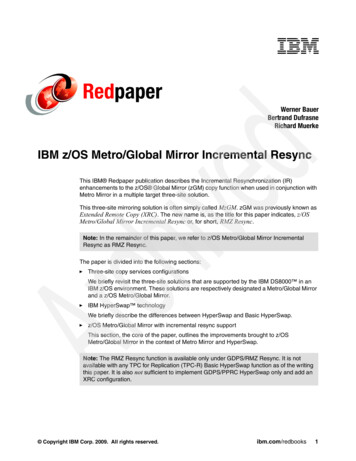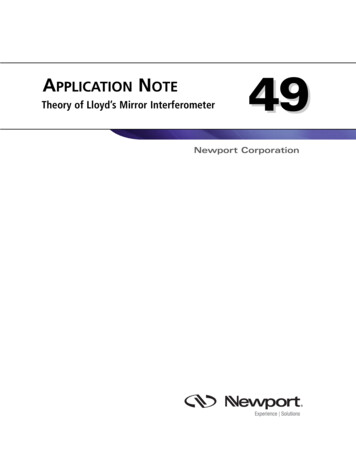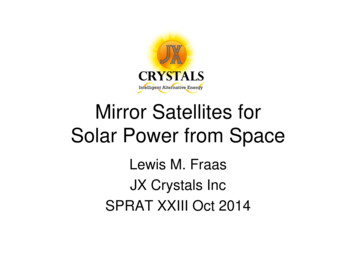
Transcription
Mirror Satellites forSolar Power from SpaceLewis M. FraasJX Crystals IncSPRAT XXIII Oct 2014
Outline Space Power Satellite Prior Art Designs Alternate SPS Design - Space Mirrors inDawn Dusk Polar Orbit Common Requirement– Space Mirrors Prior Art Space Mirror Designs Proposed Mirror Satellite Design Conclusions
Space Power Beaming Prior Art Concept – Very Complex
Power Soletta proposed by Dr. Ehricke(Prior Art Concept 1978)Advantage:Problems:Mirrors in space beaming sunlightto earth is simpler than convertingit to electricity and then microwavebeaming it down and converting itback again to electricity.1.) 4200 km orbit2.) Sun’s disc size is 10 mrad42 km diameter spot on earth3.) 180 GW power station
Recent NASA ALPHA-SPSDesign Uses Thousands ofSelf Deploying Mirrors withPointing Capability
Alternate SPS Design – Space Mirrors inSun Synchronous Dawn Dusk Polar OrbitSPS DREAMSunlight for 24 hrsper day and solarelectricity at verylow cost.Sorry, sunlight for14 hrs per daybut, yes, at verylow cost.How? Listen!Crazy IdeaSunlightEarthN
ConvergenceSpace & Terrestrial Solar CostConvergence1500Solar Power(GW)LEO LaunchCost ( /kg)10005000Years (2012 to 2022)
RevolutionaryConcept:Lightweight mirrorsin a Dawn-Dusk Orbitbeam sunlight toearth PV stationsproviding solarelectricity in evening& winter for14 hours per dayincreasingsolar power stationcapacity factorto 60% & reducingSolar electricity cost toUnder 6 cents / kWh.NASA L’Garde SunjammerSpace MirrorSpace Mirrors Normal Sunlight1210864201357911 13 15 17 19 21 23
Large Terrestrial Solar Fieldsare being installed but electricpower production in evenings& winter is desirable:Photographs of multi MW solar PV powerfields in India, California and Germany.
Concentrated Solar PowerFields are also potentialTargets for more solarelectricity in the early morningand Evening producinglower cost electricityPhotographs of 100 MWCSP field in Abu DhabiIn 2013
Spy Satellite Images from Film “Patriot Games”
Proposed Mirror Satellite ConstellationN4520oo481510This 18 evenly spacedmirror satelliteconstellation is 1000 kmhigh in a sunsynchronous orbitaround earth with a 30degree latitude andlongitude view. 30 degreelongitude equals 2 hours.N is up. The circlerepresents the earth’ssurface at 36o latitude. Asthe world turns, the targetground station moves upand the slant angle andslant range increase. 15orepresents 1 hour. Whenthe slant angle is 48o, theearth has turned 15o or 60min.The mirror satellites canbe pointed using CMGsas on the InternationalSpace Station. Here, themirror satellites are verysimplified andexaggerated in sizesimply to illustrate aconcept.
Revenue Projections and Cost for Mirror SatelliteConstellationsAssumptions – 2022 - Revenue1.) 18 satellites in dawn/dusk orbit 1000 km above earth.2.) The sun’s disc diameter viewed from earth is 10 mrad. This implies solar spot sizeon earth from a mirror up 1000 km equal 1000 tan(10 mrad) 10 km.3.) Assume each mirror satellite array has diameter of 10 km.4.) Now assume that in the year 2022 there are 40 ground stations distributed aroundthe world that the 18 satellite constellation will serve and that the constellation gives 1hr x 0.7 kW/m2 of sunlight to each station in both the morning and in the evening for atotal of 2 hr x 0.7 kW/m2 of sunlight per day per station.5.) Combined, the 40 earth stations will produce 5.5 x 40 220 GW. Assume that theprice for electricity is 0.1 / kWh, annual revenue 3x10 10 / yr 16 billion per yr.Mirror Satellite Constelation CostIt all depends on launch cost for LEO orbit (Not GEO).The ISC SPS study (4) assume 400 per kg. SpaceX Falcon Heavy (7) 1,100 per kg.MiraSolar sat (4) cost 0.6 B; constellation (4) 11 B.MiraSolar sat (7) cost 1.8 B; constellation (7) 32 B.Payback time range:Assuming 40 ground stations and 400 per kg launch cost: 0.7 years.Assuming 40 ground stations and 1100 per kg launch cost: 2 years.
Space power system comparisonsParameterMirror Sat 2022Soletta 1978ISC SPSOrbit1,000 km4,200 km36,000 km# Satellites18101Mirror Area per Sat 78 sq km462 sq km12.8 sq kmTotal Mirror Area1404 sq km4620 sq km12.8 sq km24 hr/day EarthPower40x5.5x2/24 18 GW180 GW1.2 GWGW / Mirror sq km0.0120.0390.09Cost ( 400/kg) 11 B 110 B 14 B per 24 h GW 0.7 B / GW 0.7 B / GW 11.7 B / GWEarth Station Size5.5 GW180 GW1.2 GW
Space Mirrors are a common elementfor large Space Solar Power systemsCommon requirements are:1.Self deployment2.Self pointing3.Sufficient Optical Accuracy4.Light Weight5.Durability
JAXA Prior Art – Large Deployable Reflector – In GEO since 2006
Lightweight MirrorsL’Garde Solar Sail250 m x 250 m at10 g / sq m
Origami in Space: BYU & NASA JPL designed Solar Array(Can be adapted to Mirror Satellite)
Proposed Mirror Satellite Design ConceptMake one that can be launched today & replicatedmany times as requiredVelocityVectorSunlightReflectedSunbeamA satellite mirror element isshown with 0.25 km mirrorspan. The NASA ISC SPSassumes 0.5 km diametermirrors. This MiraSolarsatellite element can serveas an initial test article aswell as a repetitive buildingelement.Each mirror satelliteconsists of lightweightmirror membranessuspended at 3 points by3 booms telescoping outfrom a center body. Thecenter body containsCMGs for attitude controland a solar panel forpower.Control Moment Gyros(CMGs) similar to thoseused on the internationalSpace Station (shownabove) can be used to pointthe mirror satellite at thedesired ground solar powerstation.
Thoughts on Origami Mirror Fold PatternUsing Large Flat Panel SegmentsThree point support with springs createslight weight optically flat mirror satellite(1)(2)(4)Z(3)YXLN # of rows (odd number)Y 2 X tan(30) 1.16 X Z 2 X / cos(30) 2.3 X L (4N 1) X A 0.435 L2Example (1): A 1200 sq mL 53 msuppose X 1 m, then N 52/4. Then N 13Example (2): L 303 m A approx 40,000 sq m. Suppose X 3 m, then (4N 1)3 303. Then N 25
Self Deploying Mirror SatelliteTelescope Sequence
Self Deploying Mirror Satellite Fanning SequenceFully deployed areais 60 times largerthan stowed area
NMinimizingManeuvers forDurabilityMirror Satellitesrotating7 revolutions per orbitaround sun pointingaxiscan easily acquire &hold on 6 targetgroundsites with minimalangular momentumadjustments &minimal energyrequirements.30o Latitude N30o Latitude SS
Mirror sweep rates for Orbit altitude 880 kmStandard sweep rate 7 revolutions per orbit 7o per orbit degreeDeg offvertical(earth center)Degrees offvertical(ground station)DeltaSweep rateDegrees perorbit .83851.299.224.611058.67.293.65
Development Road Map& PerspectiveStepsCost Estimate1. 1st Mirror Satellite for Moonlightfor 4 Disney Parks2. 18 Mirror Satellites forMunicipal Street Lighting3. 18 Mirror Array Constellationfor Ground Solar Farms4. 2x18 More Mirror ArrayConstellations for Solar Farms 10 Million 70 Million 15 Billion 2x11 BillionComparison: Three Gorges Dam vs 54 Mirror Array ConstellationCost: 37BPower (24 hour/day): 22 GWLand Use:22 GW on 700 sq km 37B54 GW5 GW on 100 sq km
Development Road MapStep #11st Mirror Satellite for Moonlightfor 4 Disney ParksA 17 m diameter mirrorin a 550 km Dawn-Dusk Orbitcould give a Full MoonEquivalent Intensity on a6 km diameter spot on earth.
Conclusions A sun synchronous dawn dusk polar orbit is an interesting orbit formirror satellites. Space mirrors in this orbit can build on momentum in terrestrial PVand CSP dramatically reducing cost of solar power from space. In any case, similar self deploying and pointing space mirrors areproposed for the NASA SPS ALPHA concept. Potential initial concerns about mirror satellite pointing, durability,and optical quality have been addressed. The time is right for a more detailed study of space mirror satellites.
the mirror satellite at the desired ground solar power station. Each mirror satellite consists of lightweight mirror membranes suspended at 3 points by 3 booms telescoping out from a center body. The center body contains CMGs for attitude control and a solar panel for power. A satellite mirror element is shown with 0.25 km mirror span.

